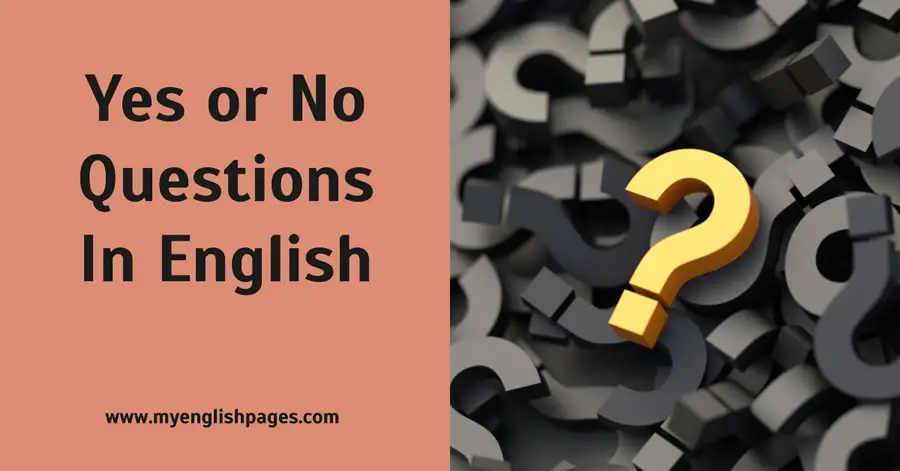Table of Contents
Introduction
Understanding how to form yes or no questions is fundamental to English grammar. These questions, also known as polar questions or closed questions, elicit responses of either “yes” or “no.”
In this article, we will explore the types of questions in English, show how to form yes or no questions and provide examples for clarity.
Types Of Questions In English
There are two types of questions in English: Yes or no questions and wh-questions:
- Yes or No Questions: These are questions whose expected answer is either “yes” or “no”. For instance, “Is she coming?” or “Are they ready?”
- Wh Questions: Wh questions (who, what, where, when, why, how) require more elaborate responses and seek specific information. For example, “What is your name?” or “Where are you going?”
Yes or no questions are questions whose expected answer is either “yes” or “no”.
How To Form Yes-No Questions

In English, a special word order (Verb Subject Object) is used to form yes or no questions.
Examples:Affirmative Yes or No Question They are American Are they American? She is nice Is she nice? He likes fruits. Does he like fruits? They visited Japan. Did they visit Japan?
The Rules for Forming Yes or No Questions

Here are three rules to form yes-no questions:
1. “To be” as the main verb:
If the main verb is “to be,” you invert the subject and the verb.
- Examples:
- They are American. — Are they American?
- They are nice. — Are they nice?
2. Main verb with helping (auxiliary) verbs or modals:
If the sentence includes a main verb and one or more helping (auxiliary) verbs or modals you invert the subject and the first helping (auxiliary) verb or modal.
- Examples:
- They are visiting Paris. — Are they visiting Paris?
- It was raining. — Was it raining?
- She has done the housework. — Has she done the housework?
- He can walk. — Can he walk?
- We should support her. — Should we support her?
- Nancy has been working all night long. — Has Nancy been working all night long?
- He will be reading the book. — Will he be reading the book?
3. Main verb without helping verbs:
If the sentence includes a verb that is not “to be” and doesn’t include a helping (auxiliary) verb, the transformation is more complex.
- a. If the verb is in the present simple tense, add either “do” or “does” and put the main verb in its base form.
- Examples:
- I like apples. — Do you like apples?
- They go to a high school. — Do they go to a high school?
- Nancy reads a lot. — Does Nancy read a lot?
- He hates basketball. — Does he hate basketball?
- Examples:
- b. If the verb is in the past simple tense, add “did” and put the main verb in its base form.
- Examples:
- He discovered the truth. — Did he discover the truth?
- She wrote a nice essay. — Did she write a nice essay?
- They did the homework. — Did they do the homework?
- Examples:
Summary of Rules:Sentence Structure Yes or No Question Structure Verb ‘to be’ Invert subject and verb Verb + Helping Verb(s)/modal Invert the subject and first helping verb or modal Verb (Not ‘to be’) Present tense: Add ‘do’ or ‘does’; Past tense: Add ‘did’
Yes Or No Questions Examples
- Are you going to the party?
- Yes, I am.
- No, I’m not.
- Did they finish their homework?
- Yes, they did.
- No, they didn’t.
- Is she studying for the exam?
- Yes, she is.
- No, she isn’t.
- Have you met my brother before?
- Yes, I have.
- No, I haven’t.
- Will he join us for lunch?
- Yes, he will.
- No, he won’t.
- Does it snow in your hometown?
- Yes, it does.
- No, it doesn’t.
- Did they watch the movie last night?
- Yes, they did.
- No, they didn’t.
- Are your parents coming to the event?
- Yes, they are.
- No, they aren’t.
- Have you ever been to Japan?
- Yes, I have.
- No, I haven’t.
- Will you help me with this project?
- Yes, I will.
- No, I won’t.
- Does your sister speak French?
- Yes, she does.
- No, she doesn’t.
- Are they enjoying the vacation?
- Yes, they are.
- No, they aren’t.
- Did you finish reading the book?
- Yes, I did.
- No, I didn’t.
- Will it rain tomorrow?
- Yes, it will.
- No, it won’t.
- Is he coming to the meeting?
- Yes, he is.
- No, he isn’t.
- Have they seen that movie before?
- Yes, they have.
- No, they haven’t.
- Do you like coffee?
- Yes, I do.
- No, I don’t.
- Did she pass the exam?
- Yes, she did.
- No, she didn’t.
- Will you be at the party tonight?
- Yes, I will.
- No, I won’t.
- Is your brother older than you?
- Yes, he is.
- No, he isn’t.
Conclusion
In English, questions can be categorized into two types: yes/no questions and wh-questions. Wh-questions are typically formed by inverting the subject and the verb to be or a helping verb, or by using the auxiliary verbs do, does, or did.
More on yes/no questions in English grammar here.


